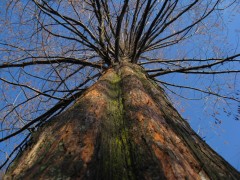

Thus, moisture conditions were the main factor affecting seed germination and seedling growth and survival of Metasequoia. While I enjoyed the flowers inside, I also was eager to catch a glimpse of their Dawn Redwood trees ( Metasequoia glyptostroboides ) outside the beautiful old glass conservatories. My family and I traveled to Phipps Conservatory in Pittsburgh, PA again this winter for their Christmas flower show. At −0.6 MPa to −0.7 MPa, seedling survival was only 12%–15%. Dawn Redwood, Metasequoia glyptostroboides, in winter. As the concentration of polyethylene glycol 6000 increased, elongation of the roots and stems first increased and then decreased, while the number of leaves and percentage of seedling survival decreased. Seed germination decreased with an increase in storage temperature, and seeds stored at room temperature (23–25 ☌) for 6 and 12 months germinated to 0–24.3%. Low water stress (−0.2 MPa to −0.4 MPa) promoted germination of Metasequoia seeds, but at −1.5 MPa to −2 MPa normal seedling emergence was only 1.4–2.4%. However, germination decreased significantly at 5 ☌ and 35 ☌.


Germination was 76%–83.2% at temperatures ranging from 10 ☌ to 30 ☌ and did not differ significantly. To explore the possible reasons for the disappearance of Metasequoia in southwest China, controlled experiments were conducted on seed germination and seedling growth and survival over a range of temperatures and at different levels of water stress. When you get closer, you’ll find that this coniferous (cone-bearing) species produces deciduous needles that are soft to the touch.

Future response of this species to a changing climate will depend on the relative rates of warming maximum temperatures in the winter and summer, as well as changing moisture conditions during the summer months.Metasequoia glyptostroboides is a well-known relict conifer species that was widely distributed in the Northern Hemisphere from the Mesozoic (Cretaceous) to early Cenozoic, after which its distributional range was contracted significantly. Each fall, the needles of Metasequoia glyptostroboides will change from vibrant green to a brilliant bronze color before they are shed for the winter. These results have implications for the future as climate change affects the native and transplanted range of this species. A positive May to June precipitation correlation is the strongest moisture signal (p < 0.05) and the narrowest rings in the chronology occurred during the drought of 1987 to 1988, consistent with one of the warmest and driest Junes on record. glyptostroboides trees planted in Secrest Arboretum in northeast Ohio, USA-shows negative correlations with maximum monthly temperatures: with the strongest relationship with February and the warm months of June and July, all significant at the 99% confidence levels. An annual ring-width chronology-spanning 1955 to 2010 and based on a stand of 19 M. Analyzing the climate response of a transplanted stand of the trees can give insights into their physiological plasticity, into their use in restoration and reforestation, as well as into interpreting the environmental conditions of the geologic past from fossil Metasequoia. Metasequoia glyptostroboides, a deciduous gymnosperm, also known as dawn redwood, was thought to be extinct until living members of the species were found in China in 1943.


 0 kommentar(er)
0 kommentar(er)
